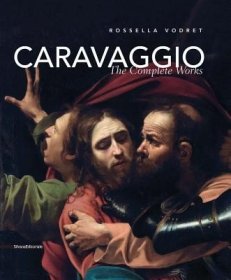
现货Caravaggio: The Complete Works[9788836637133]
¥ 495 九五品
仅1件
作者Caravaggio ; Vodret, Rossella ; Vodret, Rossella
出版社Silvana Editoriale
ISBN9788836637133
出版时间2018-02
装帧精装
纸张其他
页数216页
正文语种英语
上书时间2024-03-28
- 最新上架
商品详情
- 品相描述:九五品
- 商品描述
- "Without Caravaggio, Ribera, Vermeer, La Tour and Rembrandt could never have existed ... and the art of Delacroix, Courbet and Manet would have been utterly different." --Roberto LonghiDramatic shifts from foreboding dark to probing light, with minimal gradation in between; a realism that exposes all the flaws and folds of human flesh, eschewing Michelangelo's idealized bodies; a surgical explication of almost unbearably tense emotion; and the poised depiction of crucial moments at the very lip of their unfolding: these were among the innovations of Michelangelo Merisi, known as Caravaggio. Without them, as the great Italian art writer Roberto Longhi once noted, "Ribera, Vermeer, La Tour and Rembrandt could never have existed ... and the art of Delacroix, Courbet and Manet would have been utterly different." It was Longhi who rescued Caravaggio's painting for the 20th century, prior to which it had lain dormant since the painter's mysterious death in 1610. During Caravaggio's lifetime, however, his work was enormously influential and controversial. Each of his innovations in some way upset the prevailing tendencies of the day--not least when his insistence on physical realism led him to paint Saint Matthew as a bald peasant with dirty legs (attended upon by an irreverently intimate boy angel). Nonetheless, Caravaggio was never short of commissions or patrons, and left to posterity around 80 masterpieces. This monograph documents his complete paintings in high-quality reproductions. Authored by renowned scholar Rossella Vodret, it is the must-have monograph on the artist.Michelangelo Merisi, known as Caravaggio, was born in 1571 and made his debut in 1600 with two public commissions on the theme of Saint Matthew. He soon became notorious for his temper, and killed a young man in 1606; two further contretemps in Malta and Naples are recorded--the latter, in 1609, involving an attempt on his life--and by 1610 he was dead, after a brief but extraordinary career.
相关推荐
-
![现货Caravaggio[9780714839660]](https://www0.kfzimg.com/sw/kfz-cos/kfzimg/17733071/41e07b708658775b_s.jpg)
现货Caravaggio[9780714839660]
九五品上海
¥ 318.00
-
![现货Caravaggio[9783836523813]](https://www0.kfzimg.com/sw/kfz-cos/kfzimg/17733071/acd9712b057b523f_s.jpg)
现货Caravaggio[9783836523813]
九五品上海
¥ 170.00
-
![现货Caravaggio Bacon[9788871796239]](https://www0.kfzimg.com/sw/kfz-cos/kfzimg/17733071/cb12ca1e493ca1ed_s.jpg)
现货Caravaggio Bacon[9788871796239]
九五品上海
¥ 441.00
-
![现货After Caravaggio[9780300218640]](https://www0.kfzimg.com/sw/kfz-cos/kfzimg/17733071/6615456103e2d62b_s.jpg)
现货After Caravaggio[9780300218640]
九五品上海
¥ 506.00
-
![现货Caravaggio (Temporis)[9781859954072]](https://www0.kfzimg.com/sw/kfz-cos/kfzimg/17733071/aa780c3bccbc2572_s.jpg)
现货Caravaggio (Temporis)[9781859954072]
九五品上海
¥ 338.00
-
![现货Caravaggio (Basic Art)[9783836559935]](https://www0.kfzimg.com/sw/kfz-cos/kfzimg/17733071/617b7c479b5d9197_s.jpg)
现货Caravaggio (Basic Art)[9783836559935]
九五品上海
¥ 170.00
-
![现货Caravaggio (Chaucer Art)[9781904449225]](https://www0.kfzimg.com/sw/kfz-cos/kfzimg/17733071/8ca8147cd086f11e_s.jpg)
现货Caravaggio (Chaucer Art)[9781904449225]
九五品上海
¥ 172.00
-
![现货Caravaggio and His Legacy[9783791352305]](https://www0.kfzimg.com/sw/kfz-cos/kfzimg/17733071/137f28bd1e2779cb_s.jpg)
现货Caravaggio and His Legacy[9783791352305]
九五品上海
¥ 266.00
-
![现货Caravaggio (Masters of Art)[9783833137877]](https://www0.kfzimg.com/sw/kfz-cos/kfzimg/17733071/07feea6a2b6c5c8e_s.jpg)
现货Caravaggio (Masters of Art)[9783833137877]
九五品上海
¥ 131.00
-
![现货Utrecht, Caravaggio, and Europe[9783777431338]](https://www0.kfzimg.com/sw/kfz-cos/kfzimg/17733071/087723308a635c36_s.jpg)
现货Utrecht, Caravaggio, and Europe[9783777431338]
九五品上海
¥ 815.00
— 没有更多了 —
![现货Caravaggio: The Complete Works[9788836637133]](https://www0.kfzimg.com/sw/kfz-cos/kfzimg/17733071/145b75b14f34d235_b.jpg)

![现货Materials and Technologies of Modern Production[9783036401683]](https://www0.kfzimg.com/sw/kfz-cos/kfzimg/17733071/5fd2824531e165d7_s.jpg)
![现货Introduction to Container Ship Operations and Onboard Safety[9781032155425]](https://www0.kfzimg.com/sw/kfz-cos/kfzimg/17733071/58b7ff43ef7909ee_s.jpg)
![现货Electrophosphorescent Materials and Devices[9789814877343]](https://www0.kfzimg.com/sw/kfz-cos/kfzimg/17733071/18cc1d77bcb7b488_s.jpg)
![现货Organic Semiconductors for Optoelectronics[9781119146100]](https://www0.kfzimg.com/sw/kfz-cos/kfzimg/17733071/24c85a750c708964_s.jpg)
![现货Advances in Food Rheology and Its Applications[9780081004319]](https://www0.kfzimg.com/sw/kfz-cos/kfzimg/17733071/e0c11603c9119d4d_s.jpg)
![现货Advanced Materials and Sustainable Technologies[9783035727562]](https://www0.kfzimg.com/sw/kfz-cos/kfzimg/17733071/dced675333874c48_s.jpg)
![现货Advanced Materials and Manufacturing Engineering II[9783035712681]](https://www0.kfzimg.com/sw/kfz-cos/kfzimg/17733071/660ccfae75fa8d3e_s.jpg)
![现货Materials in Machinery and Construction[9783035718119]](https://www0.kfzimg.com/sw/kfz-cos/kfzimg/17733071/6f402060775e9daa_s.jpg)
![现货Cereal Grain Quality (Softcover Reprint of the Original 1st 1996)[9789401071772]](https://www0.kfzimg.com/sw/kfz-cos/kfzimg/17733071/f93ca1c96a97403a_s.jpg)
![现货Caravaggio: The Complete Works[9788836637133]](/dist/img/error.jpg)
以下为对购买帮助不大的评价